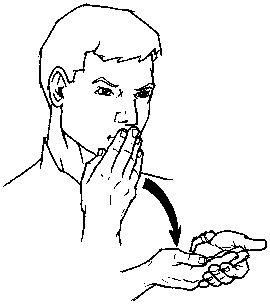In a previous post, I shared with you some of my favorite fun facts about sign language that I’ve learned as a linguistics major. Some people (okay, my dad) enjoyed that post so much that I thought I’d do a follow-up. Because I’d pretty much exhausted my knowledge about sign language in the first post, I asked someone (a hearing person) fluent in Signed English who is also an American Sign Language (ASL) major to provide me with some more fun facts for your enjoyment.
The Facts:
1. In the previous post, I told you that signed languages are not based on spoken language, and that a shared spoken language is no guarantee that two countries will have mutually intelligible sign language (e.g. the US and the UK). However, there is a dialect of sign language where signers use the same vocabulary as ASL, but use a syntax more like spoken English.
2. In ASL, the alphabet is signed with one hand. But in British Sign Language and German Sign Language, it’s signed using two hands.

American Sign Language alphabet
British Sign Language alphabet
3. In ASL and Signed English, all woman-related signs (e.g. girl, wife, daughter) are signed on the lower part of the face, usually by the jawline. All man-related signs (e.g. boy, husband, son) are signed on the upper part of the face, usually by the forehead.
4. Name signs are used to refer to a person without having to fingerspell their entire name. The sign consists of the hand shape of the first letter of the person’s name and the “sign” is something characteristic of that individual. For example, if your name is “Stephanie” and your hair is wavy you could have a name sign consisting of the letter “S” making a curl motion at the bottom of your hair. When meeting a deaf person, it is customary to tell them your name sign, to avoid the cumbersome practice of fingerspelling one’s name for each mention.
5. In some cultures, sign language consists of purely “home signs”. These are signs that people make up to use with their friends or family. Eventually, these signs become part of one’s own dialect, and are incorporated into their sign language.
6. There are five different components that make up a sign. If you change any one of these, you change the meaning of a sign. This system is how linguists can classify signs without having to show their audience a picture or a video of a sign.
a. Handshape – the general shape of the hand as it moves forms the basis of the sign.

Handshapes in ASL
b. Palm Orientation – the direction the palm is facing can change the meaning of the word. For example, in ASL, the difference between the signs for “good” and “bad” is mainly one of palm orientation

ASL sign for “bad”

ASL sign for “good”
c. Location – the same handshape in different locations can mean totally different things (as in the male and female signs discussed above.
d. Movement – one movement of a handshape and two movements of the same handshape can mean different things.
e. Facial Expressions- Your facial expressions define whether you are asking a question or making a statement. For example, furrowing your brows indicates that you are asking a WH question (who, what, why, when, where) and raising your eyebrows indicates that you are asking a yes/no question.

